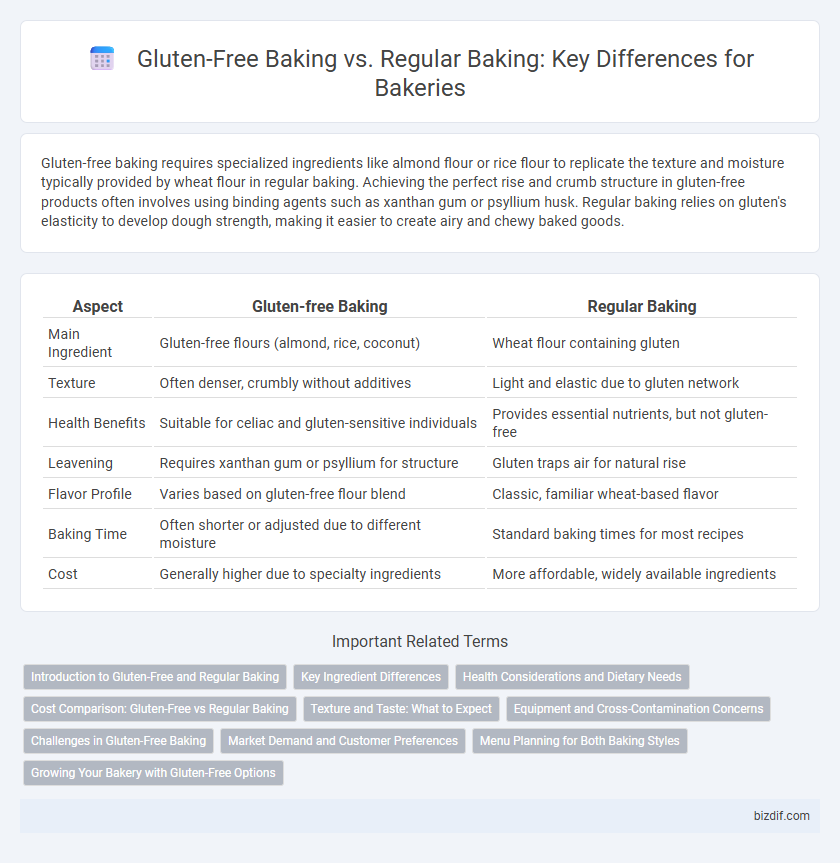Gluten-free baking requires specialized ingredients like almond flour or rice flour to replicate the texture and moisture typically provided by wheat flour in regular baking. Achieving the perfect rise and crumb structure in gluten-free products often involves using binding agents such as xanthan gum or psyllium husk. Regular baking relies on gluten's elasticity to develop dough strength, making it easier to create airy and chewy baked goods.
Table of Comparison
| Aspect | Gluten-free Baking | Regular Baking |
|---|---|---|
| Main Ingredient | Gluten-free flours (almond, rice, coconut) | Wheat flour containing gluten |
| Texture | Often denser, crumbly without additives | Light and elastic due to gluten network |
| Health Benefits | Suitable for celiac and gluten-sensitive individuals | Provides essential nutrients, but not gluten-free |
| Leavening | Requires xanthan gum or psyllium for structure | Gluten traps air for natural rise |
| Flavor Profile | Varies based on gluten-free flour blend | Classic, familiar wheat-based flavor |
| Baking Time | Often shorter or adjusted due to different moisture | Standard baking times for most recipes |
| Cost | Generally higher due to specialty ingredients | More affordable, widely available ingredients |
Introduction to Gluten-Free and Regular Baking
Gluten-free baking replaces wheat-based flours with alternatives like almond, coconut, or rice flour to accommodate dietary restrictions and celiac disease, affecting dough elasticity and texture compared to regular baking. Regular baking relies on gluten, a protein network that provides structure and chewiness in bread, cakes, and pastries, enabling traditional rising and crumb development. Understanding these fundamental differences is essential for adapting recipes to achieve desired taste and texture in gluten-free versus conventional baked goods.
Key Ingredient Differences
Gluten-free baking relies on alternative flours such as almond, rice, or tapioca to replace wheat flour, which contains gluten that provides dough elasticity in regular baking. Xanthan gum or guar gum often serves as a binding agent to replicate gluten's structure, ensuring proper texture and rise. In contrast, traditional baking depends on gluten's natural ability to trap air and provide chewiness, crucial for the structure and crumb of breads and pastries.
Health Considerations and Dietary Needs
Gluten-free baking caters to individuals with celiac disease or gluten sensitivity by eliminating wheat, barley, and rye, thus preventing adverse autoimmune reactions and digestive issues. Regular baking often includes gluten-containing flours that provide elasticity and structure, crucial for traditional bread and pastry textures but unsuitable for those with gluten intolerance. Gluten-free recipes commonly incorporate alternative flours like rice, almond, or coconut, supporting diverse dietary needs while requiring adjustments in moisture and binding agents to ensure product quality and health benefits.
Cost Comparison: Gluten-Free vs Regular Baking
Gluten-free baking ingredients such as almond flour, coconut flour, and xanthan gum typically cost 2 to 3 times more than traditional wheat flour used in regular baking. Specialized gluten-free products often require smaller batch production, increasing overhead expenses compared to mass-produced regular baking ingredients. Higher ingredient costs and the need for dedicated equipment to avoid cross-contamination contribute to the overall increased cost of gluten-free baking versus regular baking.
Texture and Taste: What to Expect
Gluten-free baking often results in a denser and crumblier texture due to the absence of gluten, which provides elasticity and structure in regular baking. Taste in gluten-free products can vary widely depending on the blend of alternative flours used, with some achieving a mild, nutty flavor but lacking the familiar chewiness of traditional wheat-based baked goods. Expect gluten-free items to be less airy and sometimes slightly grainy, while regular baked items typically offer a softer, more elastic crumb and a balanced, familiar taste profile.
Equipment and Cross-Contamination Concerns
Gluten-free baking requires dedicated equipment such as separate mixers, baking pans, and utensils to prevent cross-contamination with gluten-containing products. Regular baking tools can harbor gluten residues that pose risks for individuals with celiac disease or gluten sensitivity. Proper labeling and rigorous cleaning protocols are essential in mixed baking environments to maintain gluten-free product integrity.
Challenges in Gluten-Free Baking
Gluten-free baking presents unique challenges due to the absence of gluten, which provides elasticity and structure in regular baking. Achieving the ideal texture and moisture balance often requires precise blends of alternative flours such as rice, almond, or tapioca. Additionally, gluten-free doughs tend to be more delicate and require specialized techniques to prevent crumbling and maintain product integrity.
Market Demand and Customer Preferences
Gluten-free baking has seen a significant increase in market demand due to the rising prevalence of celiac disease and gluten sensitivities, with the global gluten-free products market expected to reach USD 9.72 billion by 2026. Customer preferences are shifting towards healthier, allergen-free options, driving bakeries to expand gluten-free product lines alongside traditional baked goods. This trend highlights the need for innovative recipes that maintain texture and flavor while catering to dietary restrictions.
Menu Planning for Both Baking Styles
Menu planning for gluten-free baking requires careful selection of alternative flours like almond, coconut, or rice flour to ensure texture and flavor mimic traditional baked goods. Incorporating binding agents such as xanthan gum or guar gum is essential to replace gluten's elasticity and provide structure. Regular baking menus can rely on wheat, rye, or barley flours, offering a broader range of traditional pastries and breads with consistent results and proven recipes.
Growing Your Bakery with Gluten-Free Options
Offering gluten-free baking options taps into a rapidly expanding market segment with a global gluten-free product market valued at over $6.4 billion in 2023. Incorporating gluten-free recipes increases customer base diversity and meets rising consumer demand driven by celiac disease awareness and lifestyle choices. Optimizing bakery operations with specialized equipment and ingredient sourcing enhances product quality and positions the business competitively in health-conscious food trends.
Gluten-free Baking vs Regular Baking Infographic

 bizdif.com
bizdif.com